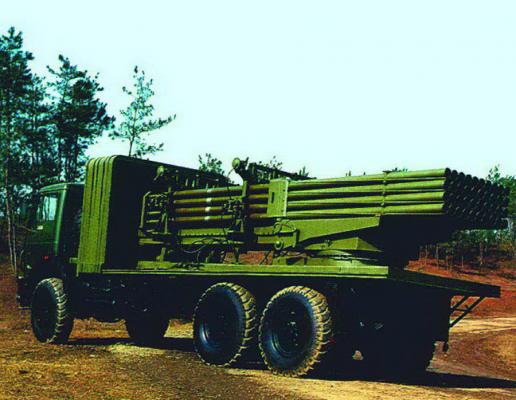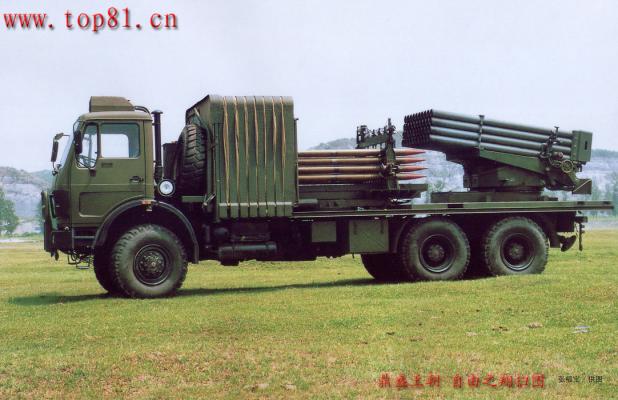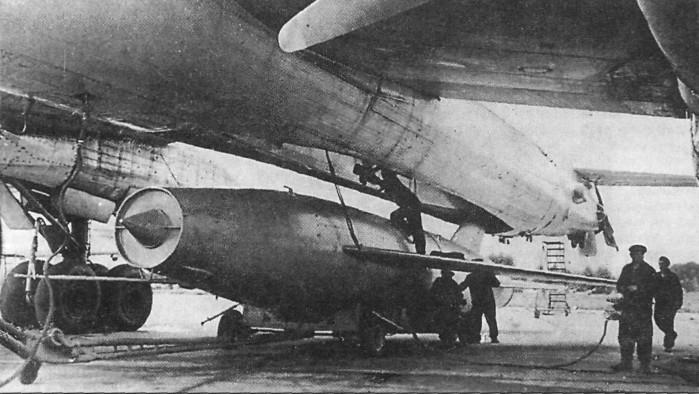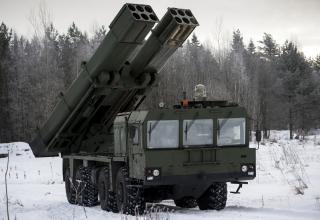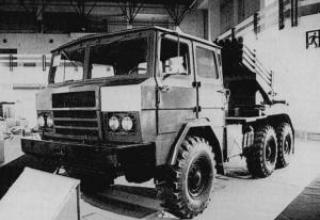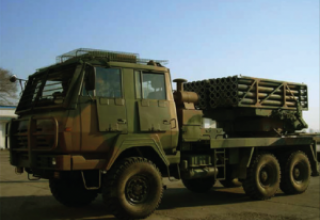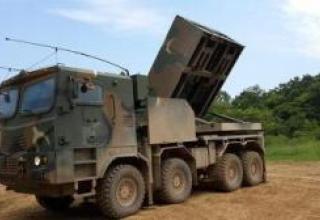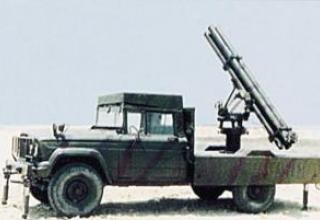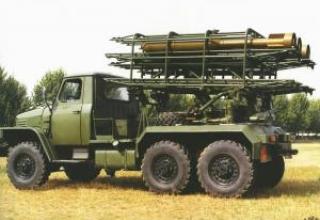The Type 90 Type 90 Type Battle Vehicle (BM) for firing 122mm unguided rockets is designed by China's NORINCO military industrial complex enterprises.
The Type 90 BM is a further development of the Chinese 122mm mortar family, which includes Type 81 and Type 89 combat vehicles, the first of which was developed on the basis of the Soviet BM-21 combat vehicle of the M-21 Field Rocket System. The Type 90 BM has been in production since the mid-1990s and is actively offered by developers on the international arms market.
The Type 90 missiles could be fired with the Type 81 BM combat vehicle.
It is currently in service with the People's Liberation Army of China and the Omani land forces. There are 327 combat vehicles assembled. The cost of the combat vehicle without shells, as of 2001, was $802,000.
The combat vehicle, unguided shells and support equipment were repeatedly refined. The upgraded version of the combat vehicle was designated Type 90A. In 2004, a new model was presented - Type 90B (photo: BM, TZM (1,2), reconnaissance vehicle (1), KShM), working in conjunction with a modern, improved automated fire control system and radar Type 704.
The design of the combat vehicles is similar to the Czechoslovak BM RM-70 and RM-70/85, Yugoslavian Oganj (1, 2, 3), its upgraded version (1), North Korean BM, Slovak prototype BM RM-70/85M, Chinese prototype BM or PR50.
Composition:
Artillery unit of the Type 90 combat vehicle is mounted on the chassis of the Tiema XC2030 6×6 8-t off-road truck (Chinese copy of the German 8-t truck Mercedes-Benz 2026. The art part includes a package of 40 tubular rails: four rows of 10 pipes in each. An additional 40-barrel rack with 40 NURS is located between the cab and the starter unit to ensure fast recharging of the main package. No armour protection is provided for the cab. Electric actuators are used to guide the operator through the elevation and horizontal firing angles.
To stabilise the combat vehicle when firing, it is equipped with hydraulically actuated jacks, which are used to minimize the effect of ground unevenness and vibration during firing. The artillery unit is controlled by the onboard control system. The on-board control system consists of an HJ-1 computer, a PU direction indicator, bevel angle and lift sensors with joint inputs, elevation angle and horizontal guidance sensors with inputs and a PM power unit. The combat machine is equipped with an automated recharging system, which consists of a hoist and a feed mechanism. The recharging mechanism can be rotated by 90°.
The LM equipment includes a communication channel and equipment to ensure communication with the central command and control point. The chassis is equipped with an air-cooled diesel engine of 300 hp.
In a camping position the combat vehicle is disguised as a tent truck (see photo).
Uncontrollable 122 mm caliber rockets with extended range are used for firing with a mixed solid fuel engine. Firing can be either single NURS or full salvo with a 0.5 second gap between the projectiles. Depending on the type of projectile, the minimum projectile range is 10-12 km, and the maximum range is 20-40 km.
Improvements to the Type 90A combat vehicle include the following:
- capability to launch all types of 122 mm caliber unguided rockets at a maximum range of 40,000 m, together with a blast and ignition head;
- the installation of a new computerized fire control system, including a global positioning system (GPS);
- a high level of automation for the operator;
- provision of guidance and control for multiple combat vehicles from the command and control vehicle.
Artillery unit of the Type 90A combat vehicle is mounted on the modified for its mounting chassis of the Tiema XC2200 6×6 truck. In fact, this is a Chinese copy of the German 8-t truck Mercedes-Benz 2026. The combat vehicle has similar characteristics as the Type 90, except for the length of the BM (9700 mm), height of the BM (3200 mm), ford depth (700 mm) and turning radius (11 m).
The Type 90B is mounted on the chassis of the Beifang Benchi 2629 6x6 truck with an extended cab, which is a copy of the German Mercedes-Benz series.
Characteristics:
| Battle machine Type 90 | |
| Length in hiking position, mm | 9840 |
| Width in hiking position, mm | 2500 |
| Height in hiking position, mm | 3245 |
| Battle weight, approx. kg. | 20 000 |
| Maximum travel speed, km/h | 85 |
| The depth of the ford to be overcome, mm | 900 |
| Turn radius, approximately, m | 12 |
| Ammunition, pcs. | 40+40 NURS |
| Salvo time, s | 18–20 |
| Automatic recharging time, less than min. | 3 |
| Number of tubular rails, pcs. | 40 |
| Guide length, mm | 3000 |
| Angle of elevation, deg: | |
| minimum | 0 |
| maximum | +55° |
| Angle of horizontal fire, deg: | |
| to the right of the chassis axle | 102° |
| to the left of the driving axle | 102° |
| Type 90B Fighting Machine | |
| Length, mm | 9315 |
| Width, mm | 2495 |
| Height, mm | 3028 |
| Maximum speed of a combat vehicle on paved roads, km/h. | 85 |
| Power reserve, km | 800 |
| Time to move from camping to combat, less min. | 7 |
| Time to move from combat to camping, less min. | 7 |
| Salvo time, s | 18–20 |
| Ammunition, pcs. | 80 NURS |
| Maximum projectile range, m | 40 000 |
| Number of tubular rails, pcs. | 40 |
| Angle of elevation, deg: | |
| minimum | 0 |
| maximum | +55 |
| Angle of horizontal fire, deg: | |
| to the right of the chassis axle | 102 |
| to the left of the driving axle | 102 |
Testing:
Operation of the K-20 in combat units of the Air Force began in August 1959, when the first missile carriers entered the 1006th TBAP in Uzin near Kiev. By the end of the year, the Tu-95K received the 1226th TBAP in Semipalatinsk, and then the 182nd TBAP in Mozdok. February 14, 1963 the first Tu-95KM arrived in Uzin.
The main objectives of the K-20 system were considered the most important military and industrial facilities in the United States. These included air bases and nuclear storage of strategic aviation in the North near the Canadian border, in Texas, California and Louisiana in the south of the country, missile bases and control centers in the central states, a cascade of energy facilities in the Great Lakes, nuclear centers and Texas oil fields (at that time, most of the oil and gas for the American economy gave its own fields), as well as naval bases and ports on the U.S. coast and islands in the Pacific and Atlantic Oceans. The courses for most of the targets were along the "Chkalov Route" - the shortest way across the pole, or to the west coast of the American continent.
Many objects were at the limit of reach, and crews regularly worked on relocations and actions from advanced airfields in the North, Far East and Arctic, where ice platforms were used (such exercises in YES were held at least twice a year). The flights were refueled, air defense breakthroughs at low altitudes, group and single strikes were mastered. The crews knew the future goals in detail, studied the environment, relief, radar and other landmarks, approaches and launch areas.
Constant combat duty in the YES regiments complicated the laborious preparation of X-20M. It was necessary to fill the rocket with fuel, special liquids, air and nitrogen, to check the systems and test the engine. If the launch was supposed to be tactical, without dropping the rocket, then often did not install a sub-basement keel, which was attached to more than a hundred screws.
The very suspension of the X-20 under the aircraft required a great deal of effort and skill. The trolley from a three-meter height was squeezed under the fuselage, forcing to turn the stirring blades of screws and jewelry "guessing" the keel of the rocket into the opening of the cargo compartment. The trolley "squatted", allowing to win the extra centimeters, but in this position after half an hour landed on the ground irrevocably. More than once during the sunset, the antennas at the top of the keel were demolished, which were protected by a special frame (with it, when "touching" the antenna remained intact, but sometimes the keel itself was crushed). To roll the X-20 required the efforts of at least 15-20 people.
The assigned resource of the X-20 was determined by the storage time, the flight under the carrier and the number of tactical launches. Repair and refinement of missiles were performed by the ARP. In this case, delivery of missiles in repair is often made by the carriers themselves Tu-95K.
Work with nuclear equipment of missiles had a proper place in combat training, but in the regiments was always carried out using special simulators and training and combat products equipped with all the necessary systems, but without a nuclear charge, allowing to practice all operations on the preparation and use of special BC.
When carrying out offsets launches X-20M were equipped with a training BC with a blast charge, which gave a noticeable explosion and "mark" at the point of impact, which allowed to judge the accuracy of the target. During the combat training from January to October 1962 the Tu-95K crews made 19 launches of X-20M, of which 15 were considered successful. By the time the K-20 was adopted into service was a quite effective system. According to the then assessment, the probability of intercepting a cruise missile by air defense fighters did not exceed 0.02 ... 0.05%, and this was confirmed by the students with the launch of the real X-20, passed through the zone of the object of air defense over one of the ranges. Even after its detection, the radar failed to point anti-aircraft missiles and interceptors to a supersonic high-altitude target - in the front hemisphere, those were ineffective, and breathtaking to catch a high-speed missile was not possible.
However, after a few years, the capabilities of the K-20 seemed insufficient. First of all, this was due to the growing level of air defense, saturated with anti-aircraft systems of zonal defense with long range and altitude, as well as supersonic fighters, capable of intercepting aircraft and shells, and the missile carriers themselves on remote borders to 1000-1200 km. The tasks of defeating strategic targets shifted to intercontinental ballistic missiles, which at that time looked like an absolute weapon. In December 1959, the Strategic Missile Forces were formed, where, in accordance with the Order of the USSR Ministry of Defense of December 31, 1959 and the directive of the General Staff of the Air Force of the former 18th, 48th and 50th IA YES were transferred to the missile parts, units and two army departments. As the units of the Strategic Missile Forces were put on combat duty, many tasks of the YES began to be assigned to them.
The regiments with the K-20 system that were in service of the Air Force were increasingly focused on solving tasks at sea - the defeat of naval bases and hunting for AUG. Ensuring their performance, the crews of missile carriers were also involved in conducting intelligence at sea, acting in conjunction with the scouts Tu-95MR. During the operation of the complex it was possible to reduce training time and labor intensiveness. Launches on maritime targets were carried out in the Caspian Sea, where the range with the appropriate telemetry and traceological equipment provided control over the flight of missiles (if necessary, in the case of failure and departure from the trajectory - their explosion). Anything happened - once in 1983, after ten years of operation of the complex, the crew mistake in tactical launch led to an involuntary discharge of the rocket. That went off the suspension with the engine running and, catching up with the plane, hit it in the fuselage. The crew successfully got home on the damaged plane, and the X-20M crashed into the sea, where it was then long and unsuccessfully sought by the Caspian Flotilla sailors.
The reliability of the complex grew as it served, reaching an acceptable level. With the last firing, conducted in 1006 TBAP in 1987, from the launched dozen missiles all worked off routinely, hitting conventional targets at the range. However, it was already a farewell chord - the combat efficiency of the K-20 complex, created in accordance with the requirements of 1954, looked disappointing, and the chances of performing a real combat mission in the conditions of modern air defense, equipped with early detection systems, air points DRLO, the latest SAMs and interceptors (and deck "Tomkata" with missiles "Phoenix" appeared just in response to the threat of Soviet missiles) - completely untenable.
However, with the write-off of the Tu-95K was not in a hurry - for a long time, long-range vehicles with air-based missiles were not fully replaced. The main emphasis was on the development of other components of the nuclear triad, and in the creation of strategic aircraft and missile weapons for them qualitative changes occurred only in the early 80's, when the long-range cruise missiles X-55. Part of the Tu-95KM, having been re-equipped for a more modern complex K-22, remained in service. Continued to be in the Air Force and the former Tu-95K - by the fall of 1990, a dozen and a half of these machines were in Ukrainka, another one remained in Uzin. These aircraft went into disrepair only after the signing of the Treaty on Strategic Offensive Arms START-1 in 1991. Thus, the service life of the K-20 complex in the Air Force was more than 30 years.
Sources:
- http://en.wikipedia.org/wiki/BM-21
- http://www.sinodefence.com/army/mrl/type90.asp
- http://www.sinodefence.com/army/transport/xc2030.asp
- Jane’s Armour and Artillery 2000-2001. – P. 766-767.
- Salim Ahmad. NORINCO’s MLRS. // SHOW Daily. – 11/4/2000. – P.15.
- The World Defence Almanac 2005. – P. 243.
- Type 90B Multiple Rocket Launcher
- 122 mm Type 90B Multiple Launch Rocket System
- Рекламный листок Oganj 2000ER. Yugoimport. На английском языке.
- Телевизионная программа "Военная тайна" от 16.10.2005 г. Телеканал RenTV.
